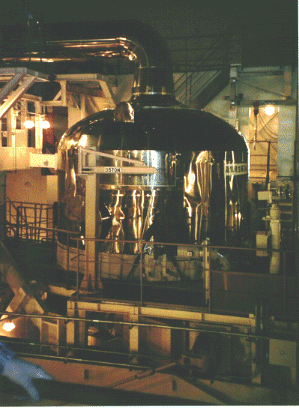
Containment - Steam Generator
The shiny component is a steam generator, as used in a pressurized water reactor facility. This unit is called a vertical U-tube design.
 |
The U is upside down. A tubesheet in the lower part of the steam generator separates the radioactive reactor coolant system from the non-radioactive secondary side. Mounted in the tubesheet are the tubes. These steam generators have over 3000 tubes, each having an inner diameter of 1/2 to 5/8 inch and an outer diameter of 5/8 to 3/4-inch. Supports in the upper parts of the steam generator stabilize the tubes to minimize movement. The large pipe at the top of the steam generator is the main steam pipe where steam leaves. Typically the normal and/or emergency feedwater will enter by a pipe mounted at the side of the steam generator. This water is sprayed downward into the outer annulus of the steam generator. The water is then routed upwards on the outside of the U-tubes where it picks up heat and is converted to a steam-water mixture. The mixture then passes through moisture-separators mounted in the upper part of the steam generator. Water falls back into the lower parts of the steam generator and steam passes out to the main steam pipe. |
The steam typically has a quality of 99.75%. This means that for every 10000 lb. of steam-water mixture leaving, there is 25 pounds water and 9975 pounds steam. Low moisture content in the steam is very important because water droplets can erode the turbine blades rotating at 1500 to 3600 rpm. Blade erosion is one reason the turbine blades are inspected every 5 or more years.
During scheduled maintenance outages or shutdowns, some or all of the steam generator tubes are inspected by eddy-current inspection. This inspection aids in determining if microscopic cracks, thinning, or wear are present. As plants age, a larger percentage of the tubes may be inspected each outage.
Copyright © 1996-2004. Joseph Gonyeau, P.E.. The Virtual Nuclear Tourist. All rights reserved. Revised: March 15, 2001.